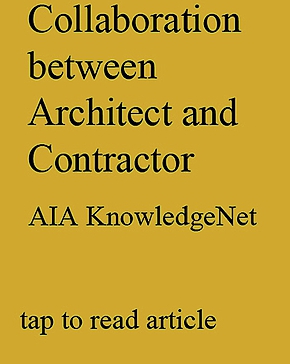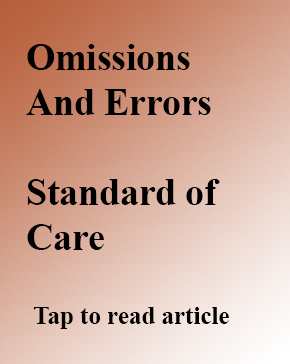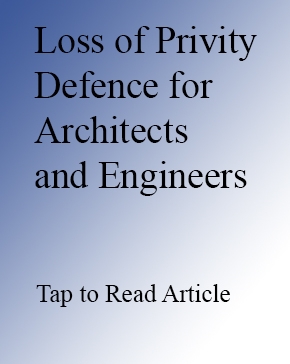by Paul Potts
 Many religious and charitable organizations prepare for a building or remodeling program in the spirit of their faith, a spirit of openness and acceptance of the goodness of human nature; however, the complexity of a million-dollar building project does not lend itself well to that kind of simplicity. Impromptu arrangements for construction often lead to financial losses.
Many religious and charitable organizations prepare for a building or remodeling program in the spirit of their faith, a spirit of openness and acceptance of the goodness of human nature; however, the complexity of a million-dollar building project does not lend itself well to that kind of simplicity. Impromptu arrangements for construction often lead to financial losses.
Finding an Architect
The first challenge is to find a suitable architect. The architect should have experience in the type of building being considered and be a member of the American Institute of Architects. No building project, especially one open to the public, can be built in the United States or Canada without a building permit. To get a building permit, the construction documents for the building must be signed and sealed by an architect and engineer registered in the state where the project is built. The same goes for mechanical, electrical and structural engineers on the design team. Most often the engineers will be hired or be on the staff of the architect, but it is fair to ask the architect for the names of the engineers who will be designing the project.
Architects are sought when the owner sends an invitation to various architects requesting a proposal. In most states architectural services are considered professional services and the owner can select the architect based on the owner’s preference with no requirement to take the lowest priced architect. Most architects work on a fee as a percentage of the construction, but in some cases a fixed sum is agreed on. The owner is entitled to and should request a list of professionals who will work on the project. Large firms have “A” teams and “B” teams. The difference in the quality and competence between and A team and a B team can have significant consequences for the owner.
Contract Documents
Contracts are a vital source of protection from fraud, defective design, defective workmanship, financial claims, failure to perform the work, failure to complete the work on schedule and other performance failures that will undermine the success of the project. The community should not rely on informal contracts drawn up by the builder or proceed with no contract at all. The best source of design and construction contract documents is the American Institute of Architects https://www.aiacontracts.org/.
If the chosen architect is a member of the AIA they will have knowledge of AIA contracting documents and how to download them from the AIA website.; however, anyone can purchase and download a fillable set of AIA contract documents from the AIA website. They do not have to be an architect. It is quite simple to do and not unduly expensive.
While I have written extensively on AIA contract documents, this article is not the place to delve deeply into them, but a little must be said. AIA contracts are the most commonly used construction contract documents in the world. They are extensively researched and regularly updated by the AIA Documents Committee and tested in court repeatedly. AIA contract documents are integrated so that Owner Architect Agreement, General Conditions to the Contract and Owner-Contractor agreement are coordinated in way that nothing required in one conflicts with requirements of the other. The only negative conclusion I have reached about the AIA documents is they are written by architects and have a bias toward defending the architect from claims by the contractor; but this is not a good enough reason to choose something less tried and true. There is an alternative set of integrated contract documents published by the Engineers Joint Contract Documents Committee (EJCDC), that are often used by engineers where there is no architect involved in the project. They are similar, but not as complete as the AIA documents.
Attorneys for the owner will often want to modify the AIA Owner-Architect Agreement to make it more favorable to the owner. This is not a good idea, because tinkering with one contract may create vulnerabilities for the owner with other contracting parties.
Finding a Builder
There are at least two methods of contracting for a church or community building – general contracting and construction management. There is also design-build, where the architect and contractors form a single contracting entity. Design-Build is more appropriate for very large public works projects and power stations that require close integration of the design and construction team. It has inherent disadvantages for the owner on smaller projects, because in the design-build arrangement the architect works for the contractor (sometimes the contractor works for the architect) leaving no independent oversight of the performance of either.
In what is called agency construction management the owner hires an architect and a construction manager. They are not required to seek bids for either because they are professional services. The construction manager is a consultant and has a superintendent on the jobsite but does not employ any of the trade contractors. The owner enters into contracts separately with each trade contractor, the plumber, the carpenter, the roofer, the painter and the electrician, etc.
There are number of traps for the owner in agency construction management. The construction manager has little contractual responsibility for the workmanship or performance of the trade contractors. Also, because each trade contractor has a separate contract with the owner, one trade contractor can sue the owner for delay of project if another trade contractor slows the project. This often happens when the mason holds up everyone else. It is also generally true, that construction management adds layers of services to the owner from keeping track of the budget and money spent to attending construction meetings with extra personnel. These extra services add costs to the project and it is slightly more expensive to build with construction management than with a general contractor.
General contracting, the traditional project contracting method, gets my vote on projects under 50-million dollars. The architect designs the project and puts it out for bids to general contractors (GC). The low bidder or the two low bidders are called in for interviews with the owner and architect and a successful GC is awarded a contract. The general contractor contracts with the trade contractors and is responsible for their performance and workmanship and keeping the trade contractors on schedule.
Payment and performance bond
The payment and performance bond is a priceless document in the hands of the owner. The payment and performance bond (PPB) is purchased by the contractor from an insurance company and furnished to the owner. The PPB protects the owner from a failure of the contractor to finish the work or correct defective work. If the contractor suffers financial failure, the bonding company will step in and complete the project. If the contractor refuses to correct proven defective work, the owner can appeal to the bonding company to correct the work or make their client correct it.
In GC contracting only one PPB is required from the GC. In agency construction management, each trade contractor will furnish a separate PPB. The owner must remain alert to get a copy of the PPB from everyone. The owner should not sign a contract with the contractor until they have a copy of the bond and general insurance coverage in hand. Some contractors have had trouble on other projects and are not able to get a bond because no insurance company will insure them. In this case the owner or architect must do more investigation.
Owner’s Builder’s Risk Insurance
The owner must purchase builder’s risk insurance to protect themselves from losses during construction. It is stated in the AIA General conditions to the Contract and it is generally accepted law, that once the owner pays the contractor for materials, equipment or some portion of the work, that belongs to the owner. If a tornado, hurricane or fire destroys that portion of the building already paid for, it is the owner’s responsibility to replace it.
Another peculiarity of construction is that the owner is responsible for materials stolen from the site if the contractor has been paid for them. The same principle applies. If the contractor has been paid for the materials they are the property of the owner. All these potential losses are covered by the owner’s builder’s risk insurance policy.
Stored Materials
It is often the case that it becomes necessary to get major equipment delivered before the building is ready for it, boilers or electrical Transformers for example, but it is necessary to have it there when the space is ready. In this case the contractor will want to be paid for the equipment while it is stored in a warehouse. Once paid for the equipment becomes the property of the owner. In this case the owner must asked for a “stored materials insurance certificate” paid for by the contractor. The stored materials insurance certificate is provided by an insurance company protecting with the owner as named insured against theft, fire or natural disaster.
Completion Penalties and Bonds
When delays in completing a building have financial consequences for owners it is appropriate to add penalties to the owner-contractor agreement that specify financial penalties for not meeting a deadline.
Low Ball Bidders
A low-ball bidder is a contractor that deliberately underprices the bid to get the work and then seeks change orders to get even again. Once the owner and contractor have a signed an agreement, they can do a lot of impertinent things to make it likely the owner will approve change orders. Contractors of this sort have many strategies for getting even. They may have even spotted oversights in the contract drawings that they will negotiate over once they have a contract. The owner must be very careful when the low bidder is significantly lower than other bidders. It is tempting to accept it as a gift, but what may look like a gift can become very expensive.
Architect’s Errors and Omissions
For several years I was a construction administrator for a very thorough and capable architectural firm, but there never was a project that didn’t require change orders to correct for the architect’s errors and omissions. Some of these mistakes were quite significant, but it is the percentage of the project cost that counts. The percentage of the budget on a 10-millon dollar project spent on architect’s and engineer’s errors and omissions could be 2 – 3 percentage of the budget and still not be unfair. The overall budget should have an allowance of 5–10 percent for things like hidden soil conditions, owner’s choices and errors and omissions. The smaller the project, higher the contingency percentage.
Owner’s Mistakes That Count
One of the most common mistakes that owner’s make is bidding the project before they have the money to build. This can be a costly mistake. For example, the owner took bids for a church project in the middle of the summer; but they didn’t have enough money to complete the project, so they put off starting work for four months while they arranged for the money. The project was in a northern climate and by the time the contractor started work winter was nearing. The contractor made a claim for “winter conditions” costs that had not been anticipated in the summer when the project was bid. The contractor successfully claimed $75,000.00 for heat, winter protection, working in frozen ground etc.
Inspection During Construction
Many owners cling to the mistaken notion that the architect is the master builder. Though, once this was true, it hasn’t been the case for decades. Even the AIA contract language has changed over the past thirty years. In 1992 the AIA Owner-Architect agreement specified that the architect acted as representative of the owner during construction. By 2009 this interpretation of the architect’s duties while at the jobsite was changed to “The Architect shall advise and consult with the Owner and Construction Manager during the Construction Phase Services.” However, through negotiation with the architect before signing the contract language can be added giving the architect responsibility for inspecting the work in progress. This would be very important for the inexperienced owner.
Conclusion
Contracting for construction can make the difference between a successful project or a crippling financial loss or disappointment in the building construction. The most frequent mistake I have noticed with inexperienced owners is becoming too chummy with the contractor. Contractors find it advantageous to be on a first-person conversation basis with the owner, but this is a contract relationship not a budding friendship. If the contractor asks the owner questions about the buildings or construction documents, the owner must insist this be discussed with the architect or engineer present.
Paul Potts is a writer for the design and construction industry. He has considerable experience as an architect’s representative during construction and owner’s oversight representative. You can reach him at PaulPotts1@comcast.net or view his professional website at https://www.pauljpotts.com.






